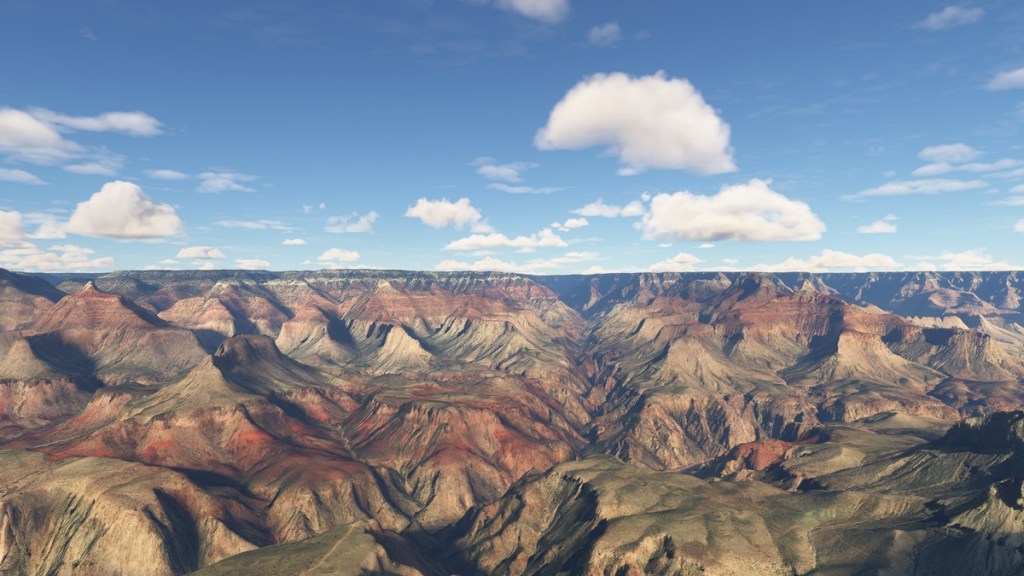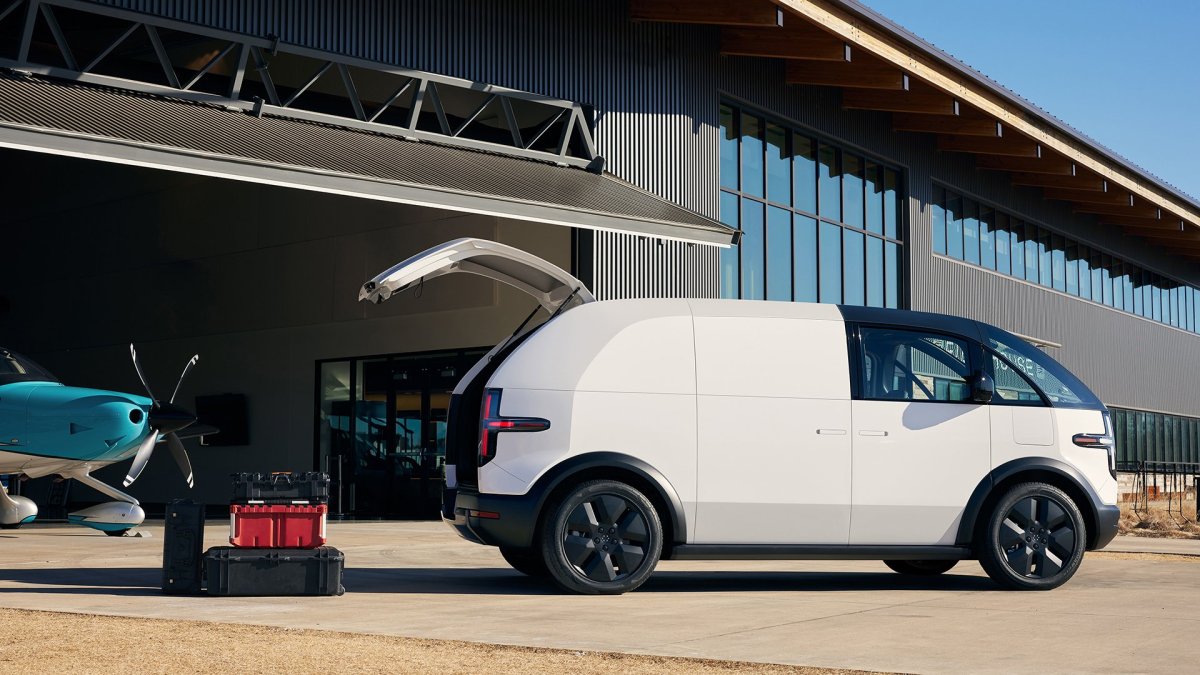Here’s the thing about asking investors for money: they want to see returns.
Technology
The contrast between reality and simulation in Microsoft Flight Simulator 2024 | David Dedeine interview

For Microsoft Flight Simulator 2024, this is a reasonable question. Is it a game, a simulation or reality?
On the reality side, the previous version in 2020 was played by 15 million people, and it spurred a desire for flight that is much needed in our modern society. Since we’re all flying around the globe so much, there’s a shortage of around 800,000 pilots.
The simulation is also so detailed — with 4,000 times more ground detail than the original game, that it has to be computed in Microsoft’s Azure cloud, which consists of a global network of data centers that can computer the game and its imagery and send it down in real time to each player’s PC or game console so that they may not realize that it wasn’t computed on their home machine.
It’s funny that one of the development leaders — David Dedeine, creative director — told me that when he flew over the Grand Canyon in real life, he finally realized his art director was right. In building the game, Wloch thought there was too much greenery around the desert-like canyon. Above the canyon, he realized that it was surrounded by forests and had trees growing out of cliffs with greenery aplenty. That means that the data that the company had collected from its real-life data sources like satellites, flight cameras and more — all of that was right.
Join us for GamesBeat Next!
GamesBeat Next is almost here! GB Next is the premier event for product leaders and leadership in the gaming industry. Coming up October 28th and 29th, join fellow leaders and amazing speakers like Matthew Bromberg (CEO Unity), Amy Hennig (Co-President of New Media Skydance Games), Laura Naviaux Sturr (GM Operations Amazon Games), Amir Satvat (Business Development Director Tencent), and so many others. See the full speaker list and register here.
And on the game side, there’s a recognition that just flying a plane — and not really fighting a war with it like in many video games — can be boring and not so fun. So the team stayed busy creating three million challenges for players to play in the game so they could be excited about the product. One of the cool things for me: flying through virtual green gates in a kind of slalom course through the Grand Canyon in a F/A-18e Super Hornet fighter jet. That’s something you can’t do in real life.
I recently joined the Microsoft Flight Simulator 2024 leaders at a briefing at the Grand Canyon, where we flew a jet and played a preview of the game, which comes out on November 19, 2024.
As part of the presentation. I was paired with game journalist Samuel Stone of Den of Geeks for an interview with Dedeine, who is creative director on the game at Asobo Studio.
His team was a big part of something like 800 people who worked on the project over as much as four years.
Here’s an edited transcript of our interview.

GamesBeat: What’s the connection between the real world and the game when it comes to the Grand Canyon? What do you notice in the game that you’ve seen here?
David Dedeine: I have a good story about that. I came here when I was 17 years old, with my parents. My memory is that it was super dry. When we were preparing the event, I was talking with the art director. I was staying in the area. His name is Patrice. “Patrice, there’s something wrong. It’s way too green here. My memory is that it’s much drier.” Patrice heard that feedback and came back to me. “No, David, I think it’s fine. It’s what it needs to be.” When we flew here with Sebastian, we looked at the environment and said, “My God.”
What I like about this story is that it shows you that how we build the game is data-driven. Species are able to grow at a specific altitude and latitude in a specific type of soil. We’re helped by all the data that helps us populate the world. But the thing is, from the sky you look down and you can’t always tell if something is just a bush or an entire tree. I was surprised to–when we flew this morning, we saw that the forest grows very close to the rim. It’s exactly like it is in the game.
GamesBeat: There are a lot of trees, and the trees are very green. But in between them there’s so much rock. It seems strange, having all the green trees against the desert rock.
Dedeine: That’s why I love this story. The systemic nature of how we build the world sometimes prevents us from creating an environment that’s influenced by our intellectual bias. “Oh my God, I was wrong. I was so wrong.” To be honest, from the sky I’ve also observed that some areas are very dry, with no vegetation. That’s also true.
Samuel Stone: One of the things that’s most ambitious about 2024 is the inclusion of all these activities. The challenge modes, the career mode. How does it strike a balance between authenticity and attention to detail while trying to avoid gamifying the experience too much?
Dedeine: One of the mantras we always use to analyze a situation, we’re working on Flight Simulator. That’s in the title. It’s a sim. As I hope you’ve observed, even in what we would consider the most game-ey part of the experience you played today, the F-18 is the same F-18 you’d use in free flight. It’s not that the experience of flying is gamified. The goal is to match the expectations of the community all over the world, what they want.

Jorg talked about this a bit. Stepping back further, even before we launched 2020, we were already thinking about the career system, the activities and so on. We were super excited. But the reality is that in order to make 2020 good, we had to shelve those developments and focus on other things.
When we launched 2020, we did several surveys post-launch. In each of those surveys, whatever type of profile–what I mean by this is gamers, hardcore sim players, digital tourists. Even sometimes people who never played video games. All across the board, the number one thing everyone wanted was more goals. They wanted purpose. We knew we needed to go for it and do the career.
Then the question was, what type of goals, and for who? We’re all of these people sometimes. I like to say that we don’t eat the same dish every single day. Sometimes you want Thai food. Even on the same day you might evolve, or even the same session. You might start by playing something very hardcore, but you’re happy to leave the session with a bit of something fun, something action.
As long as what is required as a skill in order to perform in a game activity is true to life–if it gives you a way to engage with the sim that fits your mood of the day, or the type of player you are, I think everyone is happy. We believed that was going to be the case because that’s what people were asking for. If you think about it, what’s cool about the challenges, for example, even if you’re scared of the complexity of the aircraft and you just want to enjoy the feeling of flying, or if you don’t have a lot of time, or if you’re feeling in a competitive mode, you can do the challenges. You’ll soon realize that there’s no ceiling to the performance. It’s an actual plane. The better you get at it, the better every single meter of altitude can be transformed into energy and speed. You can convert that into better times.
I don’t believe what when we’re doing challenges, which is clearly the most elaborate–it basically checks all the boxes. It’s short. It’s fast. It’s stackable. It’s competitive. It sounds like the perfect gaming mode. But simmers like it. Flight sims aren’t only one thing. It’s just an entry point.

GamesBeat: I had a question related to simmers. Do they care whether the water in the Grand Canyon is green or blue? If they want blue, and it’s actually really green when you look at it from above, what do you do?
Dedeine: They should know that it really depends–it’s a complex question. You know Bordeaux, in France? It’s very close to the sea. What’s funny is that the river there can go both ways as well, because of the tide and the rain. The Gironde river can turn a very brown color. But during the summer, if there’s not too much rain, and the ocean is pushing up into the river, pushing back the flow, it will look green. Even on a single day those kinds of things can change color. At the moment there’s no way we can fix that. Maybe one day. But that’s another plan.
What you probably refer to is how the satellite data we used to do the Grand Canyon–maybe it was a rainy day. A lot of mud was washed into the river and turned it brown. But the day you flew over it, it wasn’t that rainy, and so it was green. That’s just the way it is.
Stone: You mentioned 2020. That was the first Flight Sim to release for the Xbox Series X|S. Taking three years worth of feedback and refining the console version, what is it like when mapping and translating the 2024 experience to the Xbox?
Dedeine: It’s complex. Mapping is very important. I can give an example. I’ll talk about a specific feature. As you’ve observed, in the career, there’s the action button. The “do everything” button. It doesn’t mean that suddenly you can’t do something by yourself, looking at the actual instruments, if you want. But if you don’t want to engage with that–let me step back. What’s frustrating is that sometimes real life is easier than what you experience in the game. When you’re in front of the cockpit and you want to set the parking brake, it’s simple. It’s natural. It’s actually harder in a game. If you need to be a pianist to be able to do it, that’s a big issue.
That’s the reason why we came up with this sort of simplification for the mapping, in order to give people the opportunity to just push one button. That’s as simple as it would be in real life. It’s the same spot on the pad. In real life it might be a little different, but it better reflects how difficult it really is. I hate it when a game interface makes doing something harder than it would be in reality. We’ll continue to try to improve this.
This morning, when we were preparing for the day, we knew we needed to have game pads, game controllers. The previous day, the audience was made up of simmers. They were used to doing their own configuration. They don’t need us to help them find their way when it’s complicated. Sometimes having an objective like “Push these buttons to talk to ATC,” it’s just not fun. It becomes much harder than it is in real life. These simplifications make the pad experience closer to reality. It was something we improved.
It sounds simple presented like that, but making it work whatever the context, whatever the device, whatever the mission, but–I’ll give another example. It’s easy to say, “This button does everything.” But sometimes it’s several steps. In firefighting, you need to open the doors to pick up water. There are several levers involved in that. It informs how much we’re going to slow you down. What do we do in this case? We have just one button. We can’t suddenly say, “We need two for this thing.” That misses the point. In lots of those cases we need to find a compromise. The devil is in the details sometimes. It’s always hard until it becomes simple.

GamesBeat: What systems really matter? The example of herding the sheep with the helicopter, how many systems have to be built in order to make that happen? Is that payoff worth it? Do you think about it that way? “The payoff here is that it’s a lot of fun to herd sheep with a helicopter, so what can we do to make that happen?”
Dedeine: Technically, it’s not as hard as it might sound. It’s much harder to spawn the animals in the appropriate spots all over the planet and keep a good framerate and good memory management and so on. That’s complicated. But as soon as you’ve done that successfully, making animals flee when you get close to them–the reason why Jorg talks about this is because in the future, we hope to do a dedicated activity around this. It’s quite common in Australia, being this sort of flying cowboy. You collect a huge herd and push them into the next field. It’s something we may do in the future, but it requires other systems we don’t have yet. We have many other things to do.
That said, if you have an animal in the game, and if you fly up to it and it doesn’t react, that’s not believable. The minimum viable behavior we needed was, when you fly close to an animal, it at least needs to flee from you. That’s what we have right now. If you take a helicopter close to a herd of kangaroos, they’ll flee. But can we really do that kind of mustering yet? No.
Stone: Given the real time data around weather and environment, given the multitude and magnitude of geographic locations–I think you mentioned more than 3 million different kinds of activities. That’s a lot. How do you come up with that, presenting that breadth of gameplay?
Dedeine: There are many ways to talk about that. We’ve observed that some people, simmers or not, love to stay in one area. They’ll spend their whole life flying in Corsica, for example. We knew from the beginning that we needed to address that. We needed to address the fact that people might stay hyper-local. They’d be happy to navigate the career to perhaps the best level possible, to create their own company, but they’ll just fly in Corsica. Whatever the reason, that’s the way they like it. But there are also people who want to go everywhere on the planet.

In order to deliver all of these fantasies–plus, you add the fact that we update those missions every day. That’s how you get this number. We needed this. Another side of the answer, it’s easy to take a database and trace a line between two points. A million, even a billion, that’s easy. So it’s not just about the number. It’s about the quality.
To give you an example, if you want to make a believable scenario where you have to transport someone who’s just broken his leg on a ski slope in the winter in the Alps, bringing this guy to the closest hospital, you need a lot of different conditions. You need a ski area. You need a runway that’s close to the ski area, to justify the fact that you’re using a plane. Otherwise they’d go by car. Depending on the level of difficulty–maybe we want to make a mission that takes 20 minutes. You need to find an airport close to a town with a big hospital, to explain why you would fly there. With all those rules and constraints, you come up with a series of candidates that support the narrative scenario. But also, you need to take into account which plane is involved. Maybe the runway is super short. It’s hard to land there if your plane is too big. And so on and so on.
That’s why it’s not only about generating tons of missions. That’s easy. It’s generating missions that match the narrative aspect, but also expose the highlights, the very specific aspects of the activity you’re doing. Search and rescue with a plane–it’s funny to observe how that can become ridiculous if you start to do it too close to a city. There’s no way this guy could have gotten lost here! There’s no way you’d need an airplane to search here. You need to find a place where no cars could go, where there are no big structures. But you also need to find a place where you can land, a surface that’s large enough, long enough, and flat enough. Otherwise you can’t complete the mission.
The good news is that even with all those constraints, we came up with 3 million missions. But it’s a huge amount of filtering we have to apply to the millions or billions of possible missions. Applying those constraints when we come back with the best possible scenarios for each type of activity.
Source link
Technology
Canoo hit with two supplier lawsuits as last remaining co-founder leaves

EV startup Canoo has been hit with two new lawsuits from suppliers linked to the drivetrains that power its electric vehicles, just weeks after the company kicked off a major reorganization that included the departure of its chief technology officer.
Canoo has also parted ways with senior director of advanced vehicle engineering Christoph Kuttner, who was the last remaining co-founder from the team of nine that created the startup in late 2017, TechCrunch has learned.
Kuttner was one of nine co-founders who split off from Faraday Future at the end of 2017 to start up Evelozcity, the original incarnation of Canoo. Those co-founders have steadily slipped away from the company before, during, and after its transition from a private startup to a publicly traded company in late 2020 when it merged with a special purpose acquisition company.
Kuttner and Canoo did not immediately respond to requests for comment.
The supplier lawsuits, both of which were filed in September with Oakland County Circuit Court in Michigan, come at a time when Canoo is moving away from its original California headquarters and focusing increasingly on its operations in Texas and Oklahoma, and while courting potential customers in the U.K. and Middle East. It’s doing all of this on a tight budget. The company reported just a little more than $19 million in total cash, of which $4.5 million was unrestricted, as of June 30, 2024.
The two firms suing Canoo are Jing-Jin Electric North America and Dana Limited. Canoo had tapped Jing-Jin, or JJE, to design and build electric motors for the EV startup’s vehicles. JJE claims Canoo failed to pay for the motors and owed more than $1.4 million as of August 2023. The supplier alleges Canoo didn’t dispute the money owed and then “strung JJE along for months — repeatedly promising to pay JJE, blaming its delay on issues and factors wholly unrelated to JJE.”
In November 2023, according to the complaint, JJE and Canoo entered into a repayment plan to set things right. JJE says Canoo made its first three payments, totaling $851,013, and an additional payment of $120,649.23. But JJE says the payments stopped soon after, despite Canoo owing another $446,692.77. JJE suspended all work for Canoo in June 2024 and says the EV startup stopped responding.
Dana Limited, meanwhile, says it entered an agreement with Canoo in February 2022 to co-design and develop a drive assembly for Canoo’s vehicles. Dana Limited says that as part of the agreement, Canoo was required to compensate the supplier for any costs incurred if the EV startup’s vehicle production was delayed by more than three months.
“Canoo’s production and work under the Agreement was significantly delayed,” Dana Limited writes in the complaint. The supplier now alleges Canoo failed to make two $4.3 million cost recovery payments despite sending “several notices” to the EV startup through late 2023 and into 2024.
Servers computers
Hardy 42U Server Rack Benefits Video

Looking for reliable server racks for your data center?
Here are 10 reasons to choose the premium perforated racks from Hardy Racks!
Number 1.
The front and back sides of the rack come with a total perforation of 86%, an excellent means to dissipate over 3.5 Kilowatts of heat while allowing the free inflow of cool air.
Number 2.
The heavy-duty metal body of the 42U rack comes with a load-bearing capacity of up to 1200 kilograms!
Number 3.
The perforated front door and the perforated, space-saving split rear doors come with a one-click removable feature – and can be fitted or removed without any tools!
Number 4.
The side panels are also detachable. They come with the provision to be kept locked when not in use. These features make the massive 42U rack easy to transport, install, and seamless to work with during maintenance!
Number 5.
The sticker-free numbering of U positions – both from the top to bottom and bottom to top – makes it really convenient for identifying rack positions for installation, troubleshooting and maintenance!
Number 6.
5 cable entries on the top and 5 cable entries at the bottom – provide you with the option to bring in your cables easily, whether you have a raised flooring or false flooring setup in your data center.
Number 7. (04:43 – 04:57)
The rack is spacious enough to handle more than one PDU, which can be mounted at the back of the server rack with the help of the vertical cable manager.
Number 8.
The insulated panes between the doors and walls of the server rack is a safety feature that prevents metal to metal friction which can cause serious damage in heat-producing environments.
Number 9.
6 points of grounding at the bottom, and 1 point of grounding at the top of the rack – an extremely important safety feature for a rack that will be filled with electrical equipment!
Number 10.
The stylish, rotary handle with an in-built lock on the front door takes up virtually no extra space and can be tucked in while not in use.
From toughened body to user-friendly features and all safety amenities required for smooth operations – we have thought of everything!
But don’t just take our word for it!
All our server racks are CE certified – which is the seal of trust that indicates that our products conform to all requisite standards.
Interested in knowing more?
Give us a call at +91 844 844 47 46 or visit www.hardyracks.com.
source
Technology
OpenAI was a research lab — now it’s just another tech company

OpenAI launched with a famously altruistic mission: to help humanity by developing artificial general intelligence. But along the way, it became one of the best-funded companies in Silicon Valley. Now, the tension between those two facts is coming to a head.
Weeks after releasing a new model it claims can “reason,” OpenAI is barreling toward dropping its nonprofit status, some of its most senior employees are leaving, and CEO Sam Altman — who was once briefly ousted over apparent trust concerns — is solidifying his position as one of the most powerful people in tech.
On Wednesday, OpenAI’s longtime chief technology officer, Mira Murati, announced she’s leaving “to create the time and space to do my own exploration.” The same day, chief research officer Bob McGrew and VP of post training Barret Zoph said they would depart as well. Altman called the leadership changes “a natural part of companies” in an X post following Murati’s announcement.
“I obviously won’t pretend it’s natural for this one to be so abrupt, but we are not a normal company,” Altman wrote.
But it follows a trend of departures that’s been building over the past year, following the failed attempt by the board to fire Altman. OpenAI cofounder and chief scientist Ilya Sutskever, who delivered Altman the news of his firing before publicly walking back his criticism, left OpenAI in May. Jan Leike, a key OpenAI researcher, quit just days later, saying that “safety culture and processes have taken a backseat to shiny products.” Nearly all OpenAI board members at the time of the ouster, except Quora CEO Adam D’Angelo, have resigned, and Altman secured a seat.
The company that once fired Altman for being “not consistently candid in his communication” has since been reshaped by him.
No longer just a “donation”
OpenAI started as a nonprofit lab and later grew a for-profit subsidiary, OpenAI LP. The for-profit arm can raise funds to build artificial general intelligence (AGI), but the nonprofit’s mission is to ensure AGI benefits humanity.
In a bright pink box on a webpage about OpenAI’s board structure, the company emphasizes that “it would be wise” to view any investment in OpenAI “in the spirit of a donation” and that investors could “not see any return.”
Investor profits are capped at 100x, with excess returns supporting the nonprofit to prioritize societal benefits over financial gain. And if the for-profit side strays from that mission, the nonprofit side can intervene.
We’re way past the “spirit of a donation” here
Reports claim OpenAI is now approaching a $150 billion valuation — about 37.5 times its reported revenue — with no path toward profitability in sight. It’s looking to raise funds from the likes of Thrive, Apple, and an investment firm backed by the United Arab Emirates, with a minimum investment of a quarter-million dollars.
OpenAI doesn’t have deep pockets or existing established businesses like Google or Meta, which are both building competing models (though it’s worth noting that these are public companies with their own responsibilities to Wall Street.) Fellow AI startup Anthropic, which was founded by former OpenAI researchers, is nipping at OpenAI’s heels while looking to raise new funds at a $40 billion valuation. We’re way past the “spirit of a donation” here.
OpenAI’s “for-profit managed by a non-profit” structure puts it at a moneygrubbing disadvantage. So it made perfect sense that Altman told employees earlier this month that OpenAI would restructure as a for-profit company next year. This week, Bloomberg reported that the company is considering becoming a public benefit corporation (like Anthropic) and that investors are planning to give Altman a 7 percent stake. (Altman almost immediately denied this in a staff meeting, calling it “ludicrous.”)
And crucially, in the course of these changes, OpenAI’s nonprofit parent would reportedly lose control. Only a few weeks after this news was reported, Murati and company were out.
Both Altman and Murati claim that the timing is only coincidental and that the CTO is just looking to leave while the company is on the “upswing.” Murati (through representatives) declined to speak to The Verge about the sudden move. Wojciech Zaremba, one of the last remaining OpenAI cofounders, compared the departures to “the hardships parents faced in the Middle Ages when 6 out of 8 children would die.”
Whatever the reason, this marks an almost total turnover of OpenAI leadership since last year. Besides Altman himself, the last remaining member seen on a September 2023 Wired cover is president and cofounder Greg Brockman, who backed Altman during the coup. But even he’s been on a personal leave of absence since August and isn’t expected to return until next year. The same month he took leave, another cofounder and key leader, John Schulman, left to work for Anthropic.
When reached for comment, OpenAI spokesperson Lindsay McCallum Rémy pointed The Verge to previous comments made to CNBC.
And no longer just a “research lab”
As Leike hinted at with his goodbye message to OpenAI about “shiny products,” turning the research lab into a for-profit company puts many of its long-term employees in an awkward spot. Many likely joined to focus on AI research, not to build and sell products. And while OpenAI is still a nonprofit, it’s not hard to guess how a profit-focused version would work.
Research labs work on longer timelines than companies chasing revenue. They can delay product releases when necessary, with less pressure to launch quickly and scale up. Perhaps most importantly, they can be more conservative about safety.
There’s already evidence OpenAI is focusing on fast launches over cautious ones: a source told The Washington Post in July that the company threw a launch party for GPT-4o “prior to knowing if it was safe to launch.” The Wall Street Journal reported on Friday that the safety staffers worked 20-hour days and didn’t have time to double-check their work. The initial results of tests showed GPT-4o wasn’t safe enough to deploy, but it was deployed anyway.
Meanwhile, OpenAI researchers are continuing to work on building what they consider to be the next steps toward human-level artificial intelligence. o1, OpenAI’s first “reasoning” model, is the beginning of a new series that the company hopes will power intelligent automated “agents.” The company is consistently rolling out features just ahead of competitors — this week, it launched Advanced Voice Mode for all users just days before Meta announced a similar product at Connect.
So, what is OpenAI becoming? All signs point to a conventional tech company under the control of one powerful executive — exactly the structure it was built to avoid.
“I think this will be hopefully a great transition for everyone involved and I hope OpenAI will be stronger for it, as we are for all of our transitions,” Altman said onstage at Italian Tech Week just after Murati’s departure was announced.
Science & Environment
50 “exceptionally well-preserved” Viking skeletons unearthed in Denmark

Archaeologists said they’ve unearthed more than 50 well-preserved Viking skeletons over the past six months, providing rare insights into how the sea-faring society lived and traveled.
“This discovery offers extraordinary opportunities to perform a wide range of scientific analyses, which can reveal more about the general health, diet, and origins of those buried,” said Michael Borre Lundø, archaeologist and curator at Museum Odense, in a statement.
He added that it was “truly unusual” to find so many well-preserved skeletons at once.
The 2,000-square-meter Viking burial ground was used during the 9th and 10th centuries. It was discovered on the southern outskirts of the village of Åsum.
Museum Odense
The skeletons are so well-preserved archaeologists believe they will be able to pull DNA samples for scientific analysis. Subsequent analysis might reveal whether some of the buried Vikings were related — something that had never been examined in similar grave findings, said Borre Lundø.
“It will be incredibly exciting to learn where these people came from and whether the same families were buried here across multiple generations,” said Sarah Croix, associate professor at Aarhus University in Denmark.
Several skeletons had high standing in society, the archaeologists said, as evidenced by one of the women being buried in a wagon hull — likely the wagon she traveled in. She was buried along with a beautiful glass bead necklace, an iron key, a knife with a silver-threaded handle, and a small shard of glass that may have served as an amulet.
There was a finely decorated wooden chest at the foot of the wagon. Archaeologists do not know what was inside of the chest, but imagine the woman was buried with all of her finest things.
Other skeletons were found buried with jewelry, including one female with a metal ring around her neck, another with a single red glass bead hanging on a cord, and another with a special buckle on.
Recent Viking discoveries include nearly 300 silver coins believed to be more than 1,000 years old, which were discovered in 2023 near a Viking fortress site in northwestern Denmark. And a large Viking burial site was discovered in 2020 by Norwegian archaeologists.
Technology
Hyundai Motor and Kia team up with Samsung to strengthen infotainment in future vehicles

Automotive giants Hyundai Motor Group and Kia have announced a new strategic technology partnership with Samsung Electronics to help them transition towards the future of Software Defined Vehicles (SDVs).
Speaking to TechRadar at the Consumer Electronics Show in Las Vegas earlier this year, Chang Song, President and Head of Hyundai Motor Group Advanced Vehicle Platform (AVP) Division, explained how the Hyundai and Kia were rapidly heading towards the era of SDVs, where constantly connected cars could do more than transport occupants from A to B, offering on-demand services, the ability to interact with partner apps and control elements of the smart home.
The recent partnership with Samsung cements this notion and will further integrate Samsung’s SmartThings IoT platform with a future infotainment system that Chang Song’s department is busy developing.
This also means that Samsung’s popular Galaxy smartphones will enjoy greater integration with future cars, allowing users to check key vehicle data, such as battery range, upcoming service intervals, and even the location of their vehicles, via their phones.

In addition to this, Hyundai Motor Group also wants the vehicle to fit more seamlessly into everyday life, with the potential for one Samsung Electronics account to manage everything, including health care, pet care, and vehicle systems, in one convenient place.
Chang Song is also a founding member of 42dot, an innovative autonomous transportation company now part of the wider Hyundai Motor Group.
His vision is to create a seamless mobility system that will see one app or piece of software take care of privately owned cars, as well as the ability to summon autonomous ride-share services and potentially electronic vertical take-off and landing craft (eVTOL) like those currently being developed by sister company Supernal.
Analysis: Will ‘killer apps’ kill off the car?

The tie-up with Samsung proves Hyundai Motor and Kia’s commitment to a future where the automobile as we know it becomes more a part of our digital lives than a mere method of transport.
Chang Song spoke of his plan to invite third-party developers to create ‘killer apps’ for his future systems, which would effectively do what Internet Explorer did for Microsoft computers in the 1990s, where customers flocked to the hardware purely to take advantage of the software.
Software Defined Vehicles – and to an extent, electric vehicles – are setting the automotive industry on a path toward cars becoming a commodity, where customers treat their vehicles like smartphones, chopping and changing depending on who offers the best digital experience.
The private ownership model as we know it today will likely change, as advances in technology allow companies like Hyundai and Kia to become transport service providers rather than mere car manufacturers.
Song’s influence in software development, as well as Samsung’s recent integration, will bring more of the wider digital world into the car. Checking in on smart fridges, remotely activating the lights, and being able to locate a vehicle through a Galaxy phone is just the beginning.
you might also like
Servers computers
Rakit rack server open 8U 19 inch

Source of inspiration @chrclmnky
Terima kasih
source
-

 Womens Workouts4 days ago
Womens Workouts4 days ago3 Day Full Body Women’s Dumbbell Only Workout
-

 News5 days ago
News5 days agoOur millionaire neighbour blocks us from using public footpath & screams at us in street.. it’s like living in a WARZONE – WordupNews
-

 News1 week ago
News1 week agoYou’re a Hypocrite, And So Am I
-

 Technology1 week ago
Technology1 week agoWould-be reality TV contestants ‘not looking real’
-

 Sport1 week ago
Sport1 week agoJoshua vs Dubois: Chris Eubank Jr says ‘AJ’ could beat Tyson Fury and any other heavyweight in the world
-

 Science & Environment1 week ago
Science & Environment1 week agoITER: Is the world’s biggest fusion experiment dead after new delay to 2035?
-

 Science & Environment1 week ago
Science & Environment1 week agoMaxwell’s demon charges quantum batteries inside of a quantum computer
-

 Science & Environment1 week ago
Science & Environment1 week agoHow to wrap your mind around the real multiverse
-

 Science & Environment1 week ago
Science & Environment1 week ago‘Running of the bulls’ festival crowds move like charged particles
-

 Science & Environment1 week ago
Science & Environment1 week agoLiquid crystals could improve quantum communication devices
-

 Science & Environment1 week ago
Science & Environment1 week agoPhysicists are grappling with their own reproducibility crisis
-

 Science & Environment1 week ago
Science & Environment1 week agoSunlight-trapping device can generate temperatures over 1000°C
-

 Science & Environment1 week ago
Science & Environment1 week agoHyperelastic gel is one of the stretchiest materials known to science
-

 Science & Environment1 week ago
Science & Environment1 week agoHow to unsnarl a tangle of threads, according to physics
-

 Science & Environment1 week ago
Science & Environment1 week agoQuantum ‘supersolid’ matter stirred using magnets
-

 CryptoCurrency1 week ago
CryptoCurrency1 week agoCardano founder to meet Argentina president Javier Milei
-

 Science & Environment1 week ago
Science & Environment1 week agoWhy this is a golden age for life to thrive across the universe
-

 News1 week ago
News1 week agoIsrael strikes Lebanese targets as Hizbollah chief warns of ‘red lines’ crossed
-

 Womens Workouts7 days ago
Womens Workouts7 days agoBest Exercises if You Want to Build a Great Physique
-

 CryptoCurrency1 week ago
CryptoCurrency1 week agoDZ Bank partners with Boerse Stuttgart for crypto trading
-

 CryptoCurrency1 week ago
CryptoCurrency1 week agoEthereum is a 'contrarian bet' into 2025, says Bitwise exec
-

 Womens Workouts7 days ago
Womens Workouts7 days agoEverything a Beginner Needs to Know About Squatting
-

 Science & Environment5 days ago
Science & Environment5 days agoMeet the world's first female male model | 7.30
-

 Science & Environment1 week ago
Science & Environment1 week agoCaroline Ellison aims to duck prison sentence for role in FTX collapse
-

 Science & Environment1 week ago
Science & Environment1 week agoQuantum forces used to automatically assemble tiny device
-

 Science & Environment1 week ago
Science & Environment1 week agoNuclear fusion experiment overcomes two key operating hurdles
-

 CryptoCurrency1 week ago
CryptoCurrency1 week agoBitcoin miners steamrolled after electricity thefts, exchange ‘closure’ scam: Asia Express
-

 CryptoCurrency1 week ago
CryptoCurrency1 week agoDorsey’s ‘marketplace of algorithms’ could fix social media… so why hasn’t it?
-

 CryptoCurrency1 week ago
CryptoCurrency1 week agoRedStone integrates first oracle price feeds on TON blockchain
-

 CryptoCurrency1 week ago
CryptoCurrency1 week agoBitcoin bulls target $64K BTC price hurdle as US stocks eye new record
-

 News1 week ago
News1 week agoBrian Tyree Henry on voicing young Megatron, his love for villain roles
-

 CryptoCurrency1 week ago
CryptoCurrency1 week agoCoinbase’s cbBTC surges to third-largest wrapped BTC token in just one week
-

 News5 days ago
News5 days agoFour dead & 18 injured in horror mass shooting with victims ‘caught in crossfire’ as cops hunt multiple gunmen
-

 Womens Workouts4 days ago
Womens Workouts4 days ago3 Day Full Body Toning Workout for Women
-

 Science & Environment1 week ago
Science & Environment1 week agoNerve fibres in the brain could generate quantum entanglement
-

 Science & Environment1 week ago
Science & Environment1 week agoTime travel sci-fi novel is a rip-roaringly good thought experiment
-

 Science & Environment1 week ago
Science & Environment1 week agoLaser helps turn an electron into a coil of mass and charge
-

 CryptoCurrency1 week ago
CryptoCurrency1 week agoCrypto scammers orchestrate massive hack on X but barely made $8K
-

 CryptoCurrency1 week ago
CryptoCurrency1 week agoLow users, sex predators kill Korean metaverses, 3AC sues Terra: Asia Express
-

 CryptoCurrency1 week ago
CryptoCurrency1 week ago‘No matter how bad it gets, there’s a lot going on with NFTs’: 24 Hours of Art, NFT Creator
-

 CryptoCurrency1 week ago
CryptoCurrency1 week agoSEC asks court for four months to produce documents for Coinbase
-

 Sport1 week ago
Sport1 week agoUFC Edmonton fight card revealed, including Brandon Moreno vs. Amir Albazi headliner
-

 CryptoCurrency1 week ago
CryptoCurrency1 week agoBlockdaemon mulls 2026 IPO: Report
-
Business1 week ago
How Labour donor’s largesse tarnished government’s squeaky clean image
-

 Technology1 week ago
Technology1 week agoiPhone 15 Pro Max Camera Review: Depth and Reach
-

 Womens Workouts7 days ago
Womens Workouts7 days agoKeep Your Goals on Track This Season
-

 Travel3 days ago
Travel3 days agoDelta signs codeshare agreement with SAS
-

 Science & Environment1 week ago
Science & Environment1 week agoWhy we need to invoke philosophy to judge bizarre concepts in science
-

 Science & Environment1 week ago
Science & Environment1 week agoHow do you recycle a nuclear fusion reactor? We’re about to find out
-

 News1 week ago
News1 week agoChurch same-sex split affecting bishop appointments
-

 Technology1 week ago
Technology1 week agoFivetran targets data security by adding Hybrid Deployment
-

 CryptoCurrency1 week ago
CryptoCurrency1 week ago$12.1M fraud suspect with ‘new face’ arrested, crypto scam boiler rooms busted: Asia Express
-

 CryptoCurrency1 week ago
CryptoCurrency1 week agoCertiK Ventures discloses $45M investment plan to boost Web3
-

 CryptoCurrency1 week ago
CryptoCurrency1 week agoBeat crypto airdrop bots, Illuvium’s new features coming, PGA Tour Rise: Web3 Gamer
-

 CryptoCurrency1 week ago
CryptoCurrency1 week agoTelegram bot Banana Gun’s users drained of over $1.9M
-

 CryptoCurrency1 week ago
CryptoCurrency1 week ago‘Silly’ to shade Ethereum, the ‘Microsoft of blockchains’ — Bitwise exec
-
Business1 week ago
Thames Water seeks extension on debt terms to avoid renationalisation
-
Politics1 week ago
‘Appalling’ rows over Sue Gray must stop, senior ministers say | Sue Gray
-

 News1 week ago
News1 week agoBrian Tyree Henry on voicing young Megatron, his love for villain roles
-

 Womens Workouts7 days ago
Womens Workouts7 days agoHow Heat Affects Your Body During Exercise
-

 News5 days ago
News5 days agoWhy Is Everyone Excited About These Smart Insoles?
-

 Health & fitness1 week ago
Health & fitness1 week agoThe secret to a six pack – and how to keep your washboard abs in 2022
-

 News1 week ago
News1 week ago▶️ Media Bias: How They Spin Attack on Hezbollah and Ignore the Reality
-

 Science & Environment1 week ago
Science & Environment1 week agoQuantum time travel: The experiment to ‘send a particle into the past’
-

 Science & Environment1 week ago
Science & Environment1 week agoBeing in two places at once could make a quantum battery charge faster
-

 Science & Environment1 week ago
Science & Environment1 week agoHow one theory ties together everything we know about the universe
-

 Science & Environment1 week ago
Science & Environment1 week agoUK spurns European invitation to join ITER nuclear fusion project
-

 Science & Environment1 week ago
Science & Environment1 week agoTiny magnet could help measure gravity on the quantum scale
-

 CryptoCurrency1 week ago
CryptoCurrency1 week ago2 auditors miss $27M Penpie flaw, Pythia’s ‘claim rewards’ bug: Crypto-Sec
-

 CryptoCurrency1 week ago
CryptoCurrency1 week agoLouisiana takes first crypto payment over Bitcoin Lightning
-

 CryptoCurrency1 week ago
CryptoCurrency1 week agoJourneys: Robby Yung on Animoca’s Web3 investments, TON and the Mocaverse
-

 CryptoCurrency1 week ago
CryptoCurrency1 week ago‘Everything feels like it’s going to shit’: Peter McCormack reveals new podcast
-

 CryptoCurrency1 week ago
CryptoCurrency1 week agoSEC sues ‘fake’ crypto exchanges in first action on pig butchering scams
-

 CryptoCurrency1 week ago
CryptoCurrency1 week agoDecentraland X account hacked, phishing scam targets MANA airdrop
-

 CryptoCurrency1 week ago
CryptoCurrency1 week agoBitcoin price hits $62.6K as Fed 'crisis' move sparks US stocks warning
-

 CryptoCurrency1 week ago
CryptoCurrency1 week agoVonMises bought 60 CryptoPunks in a month before the price spiked: NFT Collector
-

 CryptoCurrency1 week ago
CryptoCurrency1 week agoVitalik tells Ethereum L2s ‘Stage 1 or GTFO’ — Who makes the cut?
-

 CryptoCurrency1 week ago
CryptoCurrency1 week agoEthereum falls to new 42-month low vs. Bitcoin — Bottom or more pain ahead?
-

 News1 week ago
News1 week agoBrian Tyree Henry on his love for playing villains ahead of “Transformers One” release
-

 Womens Workouts7 days ago
Womens Workouts7 days agoWhich Squat Load Position is Right For You?
-

 News7 days ago
News7 days agoBangladesh Holds the World Accountable to Secure Climate Justice
-

 Politics1 week ago
Politics1 week agoTrump says he will meet with Indian Prime Minister Narendra Modi next week
-

 Technology1 week ago
Technology1 week agoCan technology fix the ‘broken’ concert ticketing system?
-

 Health & fitness1 week ago
Health & fitness1 week agoThe maps that could hold the secret to curing cancer
-

 Science & Environment1 week ago
Science & Environment1 week agoA new kind of experiment at the Large Hadron Collider could unravel quantum reality
-

 Science & Environment1 week ago
Science & Environment1 week agoSingle atoms captured morphing into quantum waves in startling image
-

 Science & Environment1 week ago
Science & Environment1 week agoFuture of fusion: How the UK’s JET reactor paved the way for ITER
-

 CryptoCurrency1 week ago
CryptoCurrency1 week agoHelp! My parents are addicted to Pi Network crypto tapper
-

 CryptoCurrency1 week ago
CryptoCurrency1 week agoCZ and Binance face new lawsuit, RFK Jr suspends campaign, and more: Hodler’s Digest Aug. 18 – 24
-

 Fashion Models1 week ago
Fashion Models1 week agoMixte
-

 Politics1 week ago
Politics1 week agoLabour MP urges UK government to nationalise Grangemouth refinery
-

 Money1 week ago
Money1 week agoBritain’s ultra-wealthy exit ahead of proposed non-dom tax changes
-

 Womens Workouts7 days ago
Womens Workouts7 days agoWhere is the Science Today?
-

 Womens Workouts7 days ago
Womens Workouts7 days agoSwimming into Your Fitness Routine
-

 News2 weeks ago
News2 weeks agoBrain changes during pregnancy revealed in detailed map
-

 Science & Environment1 week ago
Science & Environment1 week agoA slight curve helps rocks make the biggest splash
-

 News1 week ago
News1 week agoRoad rage suspects in custody after gunshots, drivers ramming vehicles near Boise
-

 Science & Environment1 week ago
Science & Environment1 week agoHow Peter Higgs revealed the forces that hold the universe together
-

 Science & Environment1 week ago
Science & Environment1 week agoA tale of two mysteries: ghostly neutrinos and the proton decay puzzle
-

 Politics1 week ago
Politics1 week agoTrump Media breached ARC Global share agreement, judge rules


You must be logged in to post a comment Login